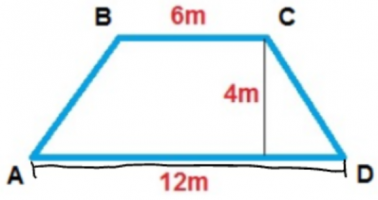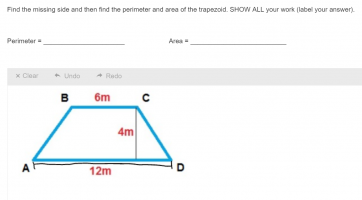You are using an out of date browser. It may not display this or other websites correctly.
You should upgrade or use an alternative browser.
You should upgrade or use an alternative browser.
Solve Trapezoids Perimeter & Area
- Thread starter jakifyrq
- Start date
D
Deleted member 4993
Guest
Do you know the equations for area and perimeter of a trapezoid?im new here and would like an answer to this question for its perimeter and area.
At this site we HELP you to find answers - based on your work that you can show us.
Please show us what you have tried and exactly where you are stuck.
Please follow the rules of posting in this forum, as enunciated at:
Please share your work/thoughts about this problem.
Dr.Peterson
Elite Member
- Joined
- Nov 12, 2017
- Messages
- 16,865
There's something missing in the problem:im new here and would like an answer to this question for its perimeter and area.

There is more than one unlabeled side, and nothing in the problem tells us that AB and CD have the same length. In the picture as drawn, they are not quite equal, and that means there is no way to find the perimeter from the given information! If you slide BC around, you can get different perimeters.
In your class, is it assumed that "trapezoid" means "isosceles trapezoid", even if the picture doesn't show that and the words don't say it?
If so, then there is a bit of a trick to find AB and CD, and that is likely to be where you are struggling (assuming you have indeed tried, and aren't just waiting to be given the answer). Think about what the base of the triangle at the right will be.
Otherwise, perhaps the expected answer for the perimeter is, "Not enough information".
The Highlander
Senior Member
- Joined
- Feb 18, 2022
- Messages
- 1,203
Let's call the point where the 4m line joins the 12m (base) line E. We can now name the triangle on the right as: CDE.
Taking a pair of imaginary scissors, you might cut off triangle CDE and have a think about where else you might place it?
If that helps, come back and tell us what answers you have come up with and we will let you know whether you have got them right.
Beware, there is a potential pitfall in this approach, so you will still need to think very carefully before coming up with both answers.
(You will still need to know the length of CD; ie: work it out!)
Dr Petersen's comments (above) are absolutely correct but it is clear that the setters of this question intended (despite the poor graphic) to provide you with an isosceles trapezium, ie: we must accept that the sides AB & CD are the same length!
Taking a pair of imaginary scissors, you might cut off triangle CDE and have a think about where else you might place it?
If that helps, come back and tell us what answers you have come up with and we will let you know whether you have got them right.
Beware, there is a potential pitfall in this approach, so you will still need to think very carefully before coming up with both answers.
(You will still need to know the length of CD; ie: work it out!)
Dr Petersen's comments (above) are absolutely correct but it is clear that the setters of this question intended (despite the poor graphic) to provide you with an isosceles trapezium, ie: we must accept that the sides AB & CD are the same length!

